A Broadwell Retrospective Review in 2020: Is eDRAM Still Worth It?
by Dr. Ian Cutress on November 2, 2020 11:00 AM ESTGaming Tests: Chernobylite
Despite the advent of recent TV shows like Chernobyl, recreating the situation revolving around the 1986 Chernobyl nuclear disaster, the concept of nuclear fallout and the town of Pripyat have been popular settings for a number of games – mostly first person shooters. Chernobylite is an indie title that plays on a science-fiction survival horror experience and uses a 3D-scanned recreation of the real Chernobyl Exclusion Zone. It involves challenging combat, a mix of free exploration with crafting and non-linear story telling. While still in early access, it is already picking up plenty of awards.
I picked up Chernobylite while still in early access, and was impressed by its in-game benchmark, showcasing complex building structure with plenty of trees and structures where aliasing becomes important. The in-game benchmark is an on-rails experience through the scenery, covering both indoor and outdoor scenes – it ends up being very CPU limited in the way it is designed. We have taken an offline version of Chernobylite to use in our tests, and we are testing the following settings combinations:
- 360p Low, 1440p Low, 4K Low, 1080p Max
We do as many runs within 10 minutes per resolution/setting combination, and then take averages.
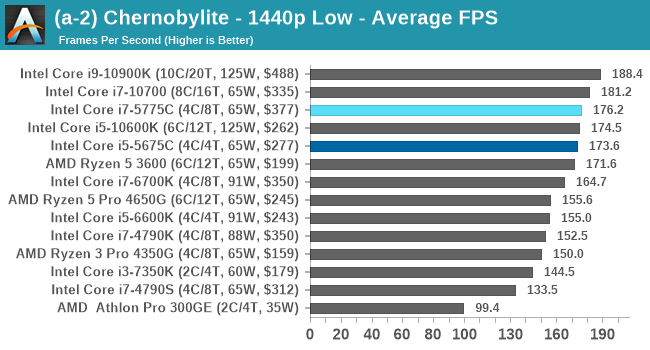
| AnandTech | Low Res Low Qual |
Medium Res Low Qual |
High Res Low Qual |
Medium Res Max Qual |
| Average FPS | 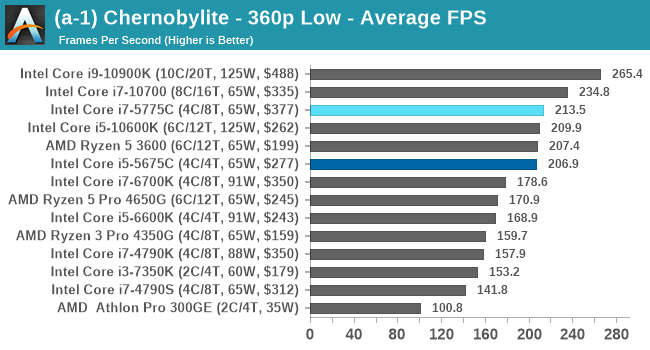 |
 |
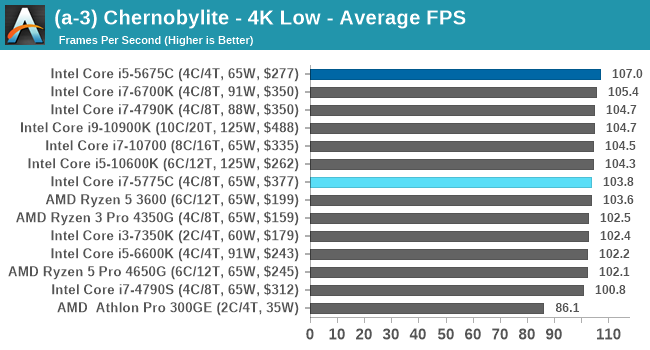 |
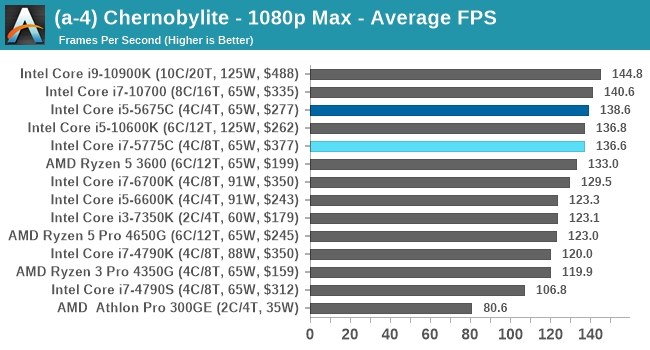 |
The Broadwell CPUs remain high performers here as the frame rates get cranked up, with the Broadwell Core i7+i5 even matching the latest Comet Lake Core i5, even at 1080p Max settings.
For our Integrated Tests, we run the first and last combination of settings.
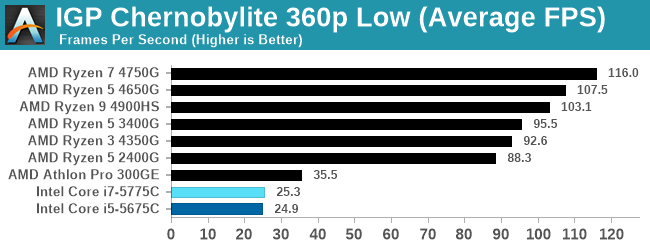
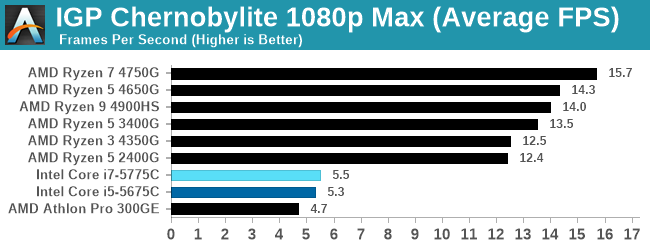
Integrated graphics shows how far AMD's basic options are ahead.











120 Comments
View All Comments
bernstein - Monday, November 2, 2020 - link
GDDR6 would be ideally suited as an L4 CPU cache... it has >500GB/s throughput and relatively low cost...e36Jeff - Monday, November 2, 2020 - link
Sure, if you build a 256-bit bus and somehow cram 8 GDDR6 chips onto the CPU package. You'd also be losing 30-40W of TDP to that.This is an application that HBM2 would be much better for. You can easily cram up to 4GB into the package with a much lower TDP impact and still get your 500+GB/s throughput. The biggest issue for this is going to be the impact of having to add in another memory controller and the associated die space and power that it eats up.
FreckledTrout - Monday, November 2, 2020 - link
This is also how I see it playing out. Certainly by the time Intel/AMD switch to using GAAFET maybe before. You just need a couple die shrinks that bring densities up and power down.bernstein - Monday, November 2, 2020 - link
scratch that, GDDR6 has much too high latency...stanleyipkiss - Monday, November 2, 2020 - link
The 5775C was ahead of its time. Don't know why they didn't go down that rabbit hole (of increasing the size with each gen)hecksagon - Monday, November 2, 2020 - link
Adding an extra 84mm2 of die area is a recipe for margin erosion, especially when the benefit is situational.CrispySilicon - Monday, November 2, 2020 - link
Well, I use a 5775C for my main home PC (using it now) and it's more than that. Broadwell was designed for low power. It doesn't run well over 4Ghz and it's not made to.My rig idles at about 800mhz, clocks up to 4ghz on all cores, 2ghz on the edram, and 2ghz on DDR3L (overclocked 1866 hyperx fury), yes, 3L, becuase THAT'S where the magic happens. Low power performance.
I've also used TridentX 2400CL10 modules in it, not worth the higher voltage.
I'm going to upgrade finally next year. CXL and DDR5 will finally retire this diamond in the rough.
Retest with nothing in the BIOS changed except the eDRAM multiplier to 20 and see what happens.
Notmyusualid - Wednesday, November 4, 2020 - link
I usually run my Broadwell at 4.4GHz 24/7. However I have a failed bios battery so using the m/b default 4.0GHz overclock settings today. I don't let mine idle at low speeds, its High Performance mode only & I only boot the Desktop for gaming, or Software Define Radio. Both of which want GHz.Memory is Vengeance LED 3200MHz (CL15 & only stable at 3000MHz, XMP is not stable either), and 32GB is currently installed.
Given;
C:\Windows\System32>winsat mem
Windows System Assessment Tool
> Running: Feature Enumeration ''
> Run Time 00:00:00.00
> Running: System memory performance assessment ''
> Run Time 00:00:05.45
> Memory Performance 54386.55 MB/s
> Total Run Time 00:00:06.65
I think that is why my Broadwell missed out on any eDRAM - it wasn't necessary.
Dolphin runs about 35x seconds, as I remember it.
6950X running cool in 2020...
MrCommunistGen - Monday, November 2, 2020 - link
HA. Epic timing. Just starting to read this now, but I recently built a system with a Broadwell-based Xeon E3 chip I got for cheap on eBay. Mostly just because I wanted to play with a chip that had eDRAM and the price of entry for an i5 or i7 has remained pretty high.This will be a very interesting read!
alufan - Monday, November 2, 2020 - link
News all day as long as its about Intel so it seems on here said it before and have seen nothing since to change my mind